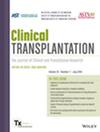Longitudinal Study on Psychological Distress Trajectory and Influencing Factors of Kidney Transplant Patients: A Potential Category Analysis Study
Abstract
Introduction
Although kidney transplantation confers substantial benefits, patients also exhibit varying levels of psychological distress attributable to multiple factors, with significant heterogeneity observed in their trajectories of change.
Objectives
This study investigates latent heterogeneous trajectories of psychological distress in kidney transplant recipients (KTRs) from pre-transplantation to 6 months postoperatively. It tests the core hypothesis that high Neuroticism (N) and Psychoticism (P) scores serve as key distinguishing predictors of these trajectory classes. The analysis also explores the influence of sociodemographic and clinical factors on class membership. By elucidating distress patterns and their underlying drivers, this research aims to facilitate early identification of high-risk patients and inform the development of personalized psychological interventions, ultimately improving treatment adherence and long-term quality of life.
Materials and Methods
A convenience sampling method was used to select 326 kidney transplant patients from the kidney transplant department of a tertiary hospital in Changsha, Hunan Province, from September 2022 to August 2024 as the research subjects. We conducted a cross-sectional survey design by using three standardized instruments: Sociodemographic variables, Eysenck Personality Questionnaire Short Scale-Chinese, and Psychological Distress Thermometer (DT) were collected at four time points: preoperative (T0), postoperative 1 week (T1), 1 month (T2), and 6 months (T3). Using a latent variable growth model to identify the developmental trajectory of psychological distress and explore its influencing factors.
Results
Three heterogeneous psychological distress trajectory classes were identified. Membership in these classes was significantly associated with the clinical course of illness, household income, and personality traits.
Conclusions
Psychological distress in KTRs exhibits significant population heterogeneity. Clinicians can utilize patients' distress trajectory patterns and temperament characteristics to implement personalized care protocols, thereby reducing distress levels.

 求助内容:
求助内容: 应助结果提醒方式:
应助结果提醒方式:


